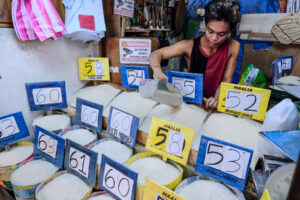
Move to impose rice safeguard measures seen negating impact of import tariff cut
By Adrian H. Halili, Reporter
THE use of safeguard measures against rice imports may end up canceling out any price declines resulting from tariff cuts, a government researcher said.
Roehlano M. Briones, a senior research fellow with the Philippine Institute for Development Studies, said safeguards measures against rice imports may “nullify the reduction in rice prices due to the tariff cut.”
“We cannot go on penalizing consumers as heavily as in the past,” Mr. Briones said via Viber.
Section 10 of Republic Act (RA) 11203 or the Rice Tariffication Law authorizes the government to impose special duties on rice imports in the event of ‘“sudden or extreme price fluctuations,” triggering a special safeguard duty under the procedures prescribed by RA 8800 or the Safeguard Measures Act.
“With tariffs at 15%, it will depend on what provisions the special safeguard duty will provide to protect farmers which will not run contrary to (the Rice Tariffication Law),” University of Asia and the Pacific Center for Food and Agribusiness Executive Director Senen U. Reyes said via Viber.
Mr. Reyes added that even with previous import tariffs at 35%, farmers have claimed that they are disadvantaged by foreign competition.
Farmers groups last week sought a delay in the execution of Executive Order (EO) No. 62 which lowered the tariffs on rice imports to 15%, until 2028, subject to a review of import duties every four months.
Agriculture Assistant Secretary and Spokesperson Arnel V. de Mesa said that any delays in carrying out EO 62 could hinder the reduction of rice prices, with broader implications for the inflation-containment effort.
“If there is a delay in imports, it will also have an impact on our national rice inventory. And of course, the possible decrease in rice prices will also be delayed,” Mr. De Mesa told reporters last week.
The Department of Agriculture (DA) said that it was projecting national rice reserves at 3.64 million metric tons (MMT) by the end of the year, equivalent to about 95 days’ demand.
The national rice inventory rose 10.3% to 2.08 MMT as of May 1, according to the Philippine Statistics Authority.
Agriculture Secretary Francisco P. Tiu Laurel, Jr. has said that the department would back a hike in rice tariffs once rice prices fall to P42 to P45 per kilogram.
Former Agriculture Undersecretary Fermin D. Adriano put forward a variable tariff regime that would save time on determining that dumping — the unfair pricing of exports — is taking place.
“The better alternative is a variable tariff system as adopted and implemented in Bangladesh,” Mr. Adriano said via Viber.
“The problem is to prove there is surge or dumping, which will take time to establish. DA does not have enough technical people to do the math and prove based on solid data that there or dumping or a surge in imports,” he added.
Leonardo A. Lanzona, Jr., an economics professor at the Ateneo de Manila, said that the government should also provide subsidies on a large scale.
“Agriculture cannot be ignored in this case. The government must subsidize a massive agricultural development program, not only raising production but distributing income as well,” Mr. Lanzona said via Messenger chat.
Tariff collections from rice imports support rice farmers through the Rice Competitiveness Enhancement Fund, with an annual allocation of P10 billion. The excess is also used for financial assistance to rice farmers.
The US Department of Agriculture is projecting Philippine imports at 4.6 MMT this year, driven by the cut in tariffs. If realized this would be 27.8% higher than the 3.6 MMT reported in 2023.



